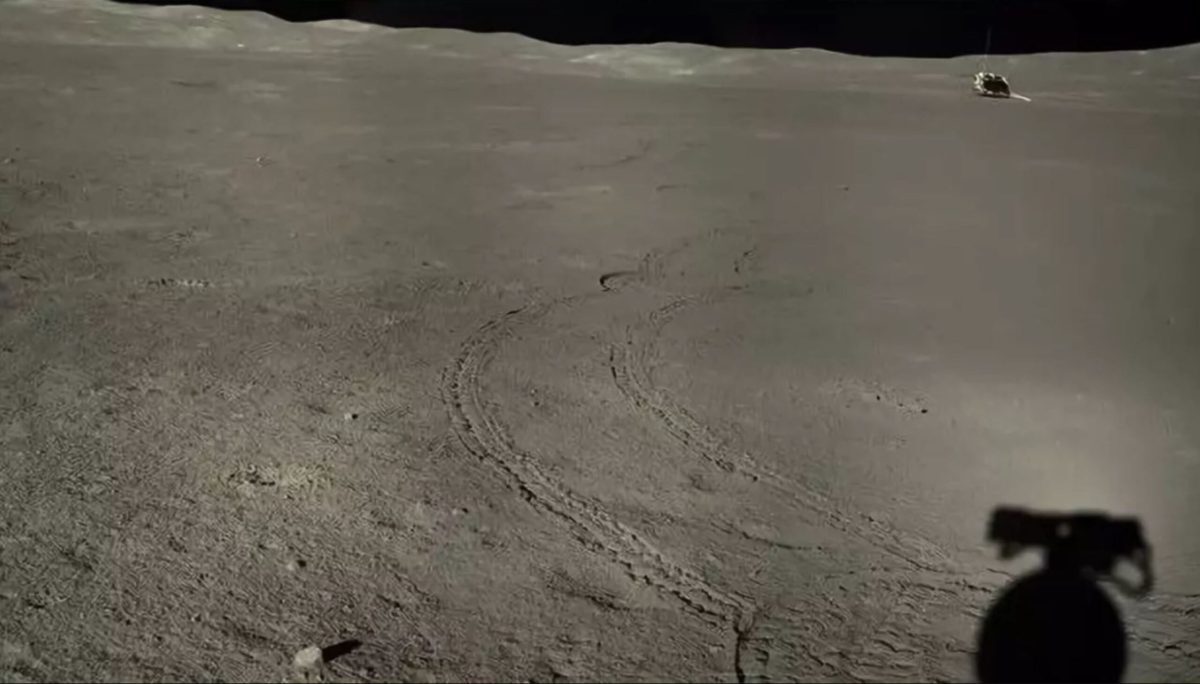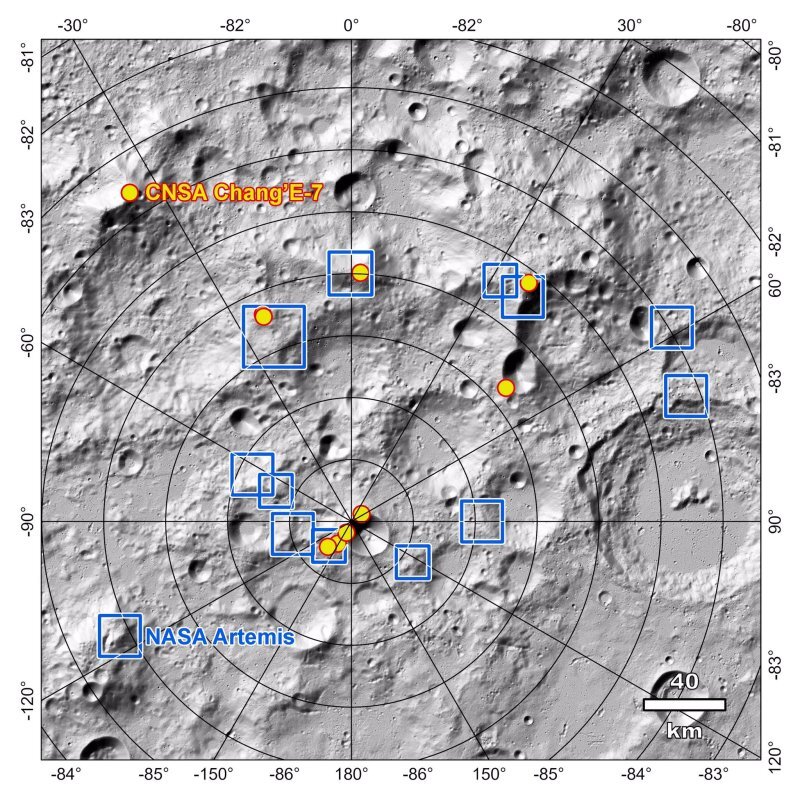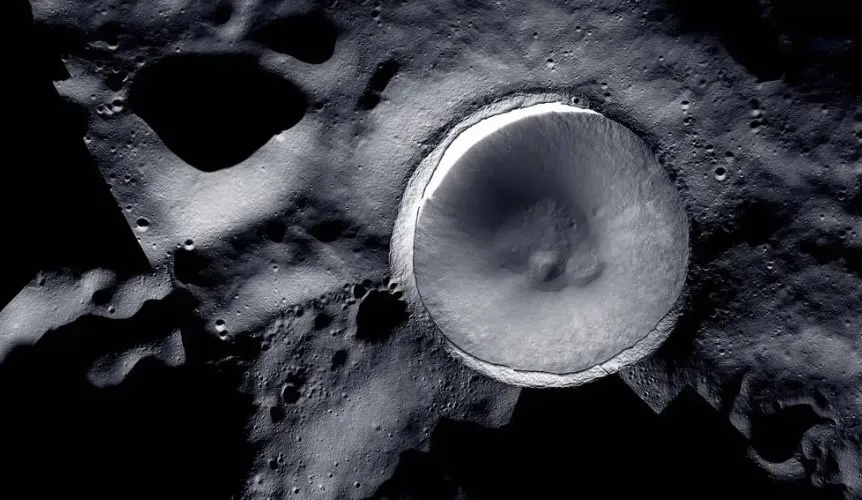26.03.2023
China loses UAE as partner for Chang’e-7 lunar south pole mission

Stitched images from the Yutu-2 rover showing the distant Chang'e-4 lander. Credit: CNSA/CLEP Credit: CNSA/CLEP
HELSINKI — An agreement for a United Arab Emirates’ rover to fly on China’s Chang’e-7 lunar mission has apparently been hit by U.S. export control rules.
China and the UAE signed a memorandum of understanding in September 2022 for the Rashid II rover to fly on lander of the multi-spacecraft Chang’e-7 mission.
However, that agreement has fallen foul of the U.S. government’s International Traffic in Arms Regulations (ITAR), according to a report from the South China Morning Post, citing anonymous sources.
ITAR prohibits the sale or export of a list of components, technologies and software classified as defense-related on grounds of national security issues. The rules apply to all US citizens and businesses, as well as foreign companies and individuals that have access to items of U.S.-origin designated under ITAR.
Conversely, the UAE’s Rashid I rover recently entered lunar orbit aboard a Japanese commercial moon lander. The HAKUTO-R Mission 1 launched in December on a SpaceX Falcon 9.
The export control rules aim to restrict access of certain actors including China to sensitive U.S.-made components, impacting China’s role in the international launch market and impacting cooperation.
Components developed to be ITAR-free have allowed entities in China and Europe to collaborate, while China has also looked to deliver turnkey space solutions—providing launch, spacecraft, ground support and so on—to lesser developed nations in order to avoid the barriers of ITAR.
The regulations have also been perceived to hit U.S. companies which have also been cautious of violating sometimes nebulous ITAR controls.
Rumors that the partnership had ended had appeared on Chinese social media in recent weeks. No official comment has been made.
China recently worked to grow cooperation with emerging space nations including Saudi Arabia and the United Arab Emirates.
The development, if confirmed, would be a blow to China’s efforts to attract partners for its lunar exploration plans.
China is working towards constructing an International Lunar Research Station (ILRS) in the 2030s, with the Chang’e-7 and Chang’e-8 missions touted as a basic model for the plan.
Further complicating the issue is Russia’s founding participation in the ILRS project. Chinese officials presented opportunities for international participation on Chang’e-7 and other lunar and deep space missions at the International Astronautical Congress (IAC) in Paris last September. The officials did so however without mentioning Russia as a partner, with the country facing international isolation in the wake of its invasion of Ukraine.
Opportunities to join Chang’e-7 were reiterated at meetings of the Committee on the Peaceful Uses of Outer Space (COPUOS) in February this year, with 10 kilograms of payload available on the Chang’e-7 lander, with a further 15 kg aboard the orbiter. The loss of the Rashid II rover means a further 10 kilograms will be once again available on the lander.
Also at the meetings Chinese officials revealed that it had pre-selected landing areas at Shackleton crater at the lunar south pole and the nearby Shoemaker crater, downselecting from a wider range of earlier potential sites. The specific landing site was still to be determined.

A map of the lunar south pole showing potential landing sites for both NASA’s Artemis 3 and China’s Chang’e-7 mission. (Credit: Dan Moriarty)
NASA is also considering landing sites at Shackleton for the Artemis 3 mission. China and NASA had previously identified a number of overlapping potential landing sites.
China is set to launch a relay satellite in 2024 to support the upcoming Chang’e-6 lunar far side sample return and Chang’e-7 lunar south pole landing missions.
Quelle: SN
----
Update: 31.01.2024
.
China’s Chang’e-7 moon mission to target Shackleton crater

A mosaic of Shackleton Crater created by the Lunar Reconnaissance Orbiter Camera and ShadowCam teams. Credit: NASA/KARI/ASU
HELSINKI — China will attempt to land on the illuminated rim of Shackleton crater near the lunar south pole with its 2026 Chang’e-7 mission.
Chang’e-7 will target one of a handful of sites thought to offer exceptionally long periods of illumination at the lunar south pole, according to a recently-published journal article.
The area, stated to be the illuminated rim of Shackleton crater, possibly corresponds to a candidate landing site for NASA’s Artemis 3 crewed mission named Peak Near Shackleton.
Such a site could offer favorable illumination while also being close to permanently shadowed regions which could host volatiles such as water-ice.
Chang’e-7 aims to provide valuable data for future lunar exploration and the potential utilization of lunar resources. The mission also is a cornerstone for China’s plans to establish an international lunar base in the 2030s.
China’s preparatory plans to establish its International Lunar Research Base (ILRS) include the Chang’e-8 south polar resource utilization mission. This is planned to launch no earlier than 2028.
Together the Chang’e-7 and -8 mission will form a basic outline of the ILRS, according to earlier announcements.
China is currently attempting to attract partners to the ILRS. Egypt is the most recent country to sign up, in December 2023.
The multi-component Chang’e-7 mission will feature an orbiter, a lander, a rover and a mini-flying probe. These will investigate the lunar south pole’s environment and resources with the support of a communications relay satellite.
The latter, named Queqiao-2, is expected to launch in the coming months to support upcoming and ongoing missions.
Science objectives
The article, published late December in National Science Review, lays out a series of science objectives. These include detecting lunar soil water ice and volatile components, studying lunar morphology, composition and structure. It also names payloads, including a seismometer, ground-penetrating radar, magnetometer, spectrometers and more.
The return from the mission could be transformational for science and human exploration, Clive Neal, a professor and lunar scientist at the University of Notre Dame, told SpaceNews.
“Obtaining seismic data from the south pole will be important if the seismometer can record for an extended period of time, as it can show the severity of shallow moonquake activity at the south pole,” Neal says.
“Shallow moonquakes were shown by the Apollo seismic data to potentially have body wave magnitudes between 5 and 6 with maximum ground amplitude lasting up to 10 minutes. While no shallow moonquakes fell within the narrow aperture of the Apollo passive seismic network, at least one was estimated to originate from the south polar region.
“Therefore, CE-7 seismic will inform how to construct the ILRS and the Artemis base camp such that they can withstand such high magnitude seismic events.”
Chang’e-7 will also focus on volatiles. The mini-flying probe will carry a single payload, the Lunar Soil Water Molecule Analyzer (LSWMA). This is designed to collect water molecule and hydrogen isotope data at a specified site.
The Lunar Neutron Gamma Spectrometer (LNGS) aboard the orbiter will be tasked with ascertaining the distribution and source of lunar water ice in the lunar south pole region and permanently shadowed areas.
| Chang’e-7 Science Objectives | |
|---|---|
| 1 | Distribution and origins of lunar soil water ice and volatile components. |
| 2 | Study of lunar morphology, composition, and structure. |
| 3 | Detection and research of the moon’s internal structure, magnetic field, and thermal characteristics. |
| 4 | Comprehensive detection and research of the lunar south pole lunar surface environment. |
| 5 | Moon-based detection and research of the Earth’s magnetotail and plasma layer. |
| 6 | Lunar-Earth VLBI measurement experiments and observation studies. |
The first step for Chang’e-7 will be the launch of the Queqiao-2 relay satellite.
Queqiao-2 is set to launch on a Long March 8 rocket from the coastal Wenchang spaceport in early 2024, an official with the satellite’s developer said in October. That launch could take place as soon as February.
The 1,200-kilogram satellite will feature a 4.2-meter-diameter parabolic antenna and a mission lifetime of more than eight years.
Queqiao-2 will initially support the unprecedented Chang’e-6 lunar far side sample return mission, expected to launch around May. It will also assist the continued operations of the Chang’e-4 lunar far side lander and rover mission.
The relay satellite will also carry three payloads which will play a role in the overall Chang’e-7 science objectives. Queqiao-2 will operated in a 24-hour-period, elliptical frozen orbit to support Chang’e-6. It will change to a similar, 12-hour-period orbit for missions 7 and 8.
International cooperation
The China National Space Administration announced opportunities to join the Chang’e-7 mission in early 2023.
The National Astronomical Research Institute of Thailand (NARIT) agreement to join ILRS. This coincided with a payload proposed by the institute being announced as accepted to join the Chang’e-7 mission.
The United Arab Emirates and China signed a memorandum of understanding in September 2022 for the UAE to fly a small lunar rover on the mission. This plan was later reported to have been hit by U.S. ITAR rules. The recent paper does not mention the rover nor the NARIT payload.
The journal paper provides a list of payloads to fly on the five separate Chang’e-7 spacecraft.
| Scientific Payload | Name | Function | Spacecraft |
|---|---|---|---|
| 1 | LOVEX | Moon-Earth VLBI measurement and observation experiment | Relay Satellite (Queqiao-2) |
| 2 | GENA | Energetic Neutral Atom Imager for Earth’s magnetotail imaging | Relay Satellite (Queqiao-2) |
| 3 | EUC | Extreme Ultraviolet Camera for Earth’s plasmasphere observation | Relay Satellite (Queqiao-2) |
| 4 | HRSMC | High-Resolution Stereo Mapping Camera | Orbiter |
| 5 | MSAR | Miniature Synthetic Aperture Radar | Orbiter |
| 6 | WISMIA | Infrared Spectrum Mineral Imaging Analyzer | Orbiter |
| 7 | LNGS | Lunar Neutron Gamma Spectrometer | Orbiter |
| 8 | LOM | Lunar Orbit Magnetometer | Orbiter |
| 9 | LS | Lunar Seismograph | Lander |
| 10 | LSEDS | Lunar Surface Environment Detection System | Lander |
| 11 | LC | Landing Camera | Lander |
| 12 | TC | Topography Camera | Lander |
| 13 | PC | Panoramic Camera | Rover |
| 14 | RM | Rover Magnetometer | Rover |
| 15 | LRS | Lunar Raman Spectrometer | Rover |
| 16 | LPR | Lunar Penetrating Radar | Rover |
| 17 | IsMSV | In-situ Measuring System of Volatiles on Lunar Surface | Rover |
| 18 | LSWMA | Lunar Soil Water Molecule Analyzer | Mini-Flying Probe |
Chang’e-7 is currently scheduled to launch on a Long March 5 rocket in 2026 from the Wenchang Satellite Launch Center.
Quelle: SN
